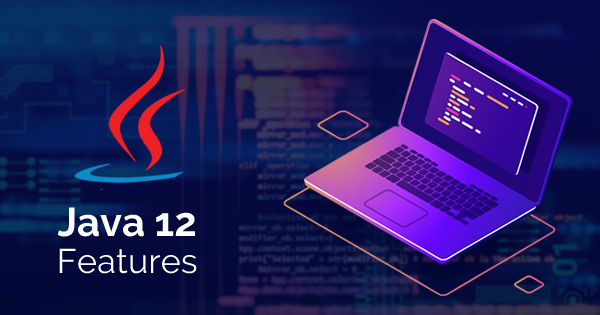The popularity of many programming languages is one of the formidable highlights that we notice in the IT world. However, one of the programming languages has never failed to lose its reputation that is Java. Java is as popular now as it was 23 years ago when it was introduced. Recently, the latest release of Java came to the market with the Java Development Kit (JDK) 12. In this discussion, we’ll throw light on the Java 12 features.
The excitement to know more about Java 12 features is skyrocketing in the present times. Since the major release of Java SE 9+, Java follows a six-month release cycle. This is a clear indicator that the programming language and virtual machine are going through faster improvements to cope with rapid technology innovation.
What’s New in Java 12 Features
Every new version of Java since Java SE 9 till the latest Java 12 has new changes. While we attempt to take a look at what’s new in Java 12, the bundle of changes is inevitable. They can include library additions, modifications in the JDK clean-up process, and new language features. So, the following discussion aims to point out the different new features that you can get with Java 12.
-
New Additions
The first entry among Java 12 new features is visible in the facility of support for Unicode 11. With the new Java 12 release, support for Unicode 11.0.0 is no more an issue. Java 11 features included support for Unicode 10.0.0. Now, after the introduction of new features of Unicode 11.0.0, Java 12 provides updated support for the additions.
The new features under concern here include 684 new characters, 11 new blocks, and seven new scripts. The 684 new characters primarily involve additions such as 66 emoji characters and a Copyleft symbol. The other new characters include half stars for rating systems, Xiangqi Chinese chess symbols, and additional astrological symbols.
The new Java 12 features also include seven new scripts such as Sogdian, Old Sogdian, Medefaidrin, Hanifi Rohingya, Dogra, Makassar, and Gunjala Gondi. Among the 11 new blocks in Java 12, seven blocks are ideal for these new scripts. The remaining four blocks are ideal for the existing scripts. The existing scripts include Chess Symbols, Georgian Extended, Indic Siyaq Numbers, and Mayan Numerals.
Java SE 11 Developer is the most recent certification for Java professionals to validate their skills. If you’re preparing to become Java 11 developer, check how you can achieve Oracle Certified Java SE 11 Developer certification.
-
Shenandoah
The next entry among new features with a Java 12 download is the low pause-time garbage collector, Shenandoah. This new garbage collection (GC) algorithm is experimental. Shenandoah is ideal for applications that demand higher responsiveness and better predictability of short pauses. Shenandoah is one of the striking new Java 12 features that can improve the performance of programs.
This algorithm can help programs to run with the available memory capacity. Shenandoah also helps in the optimization of programs to prevent interruptions in running programs lasting more than a few milliseconds. The Shenandoah algorithm supports the garbage collection pause-time by implementing evacuation work in unison with running Java threads. Shenandoah helps in trading concurrent CPU cycles and space for introducing pause time improvements.
Most important of all, the pause times do not depend on heap size, thereby implying the facility of consistent pause-times. However, Oracle also states clearly that this new algorithm is not meant for addressing all JVM pause issues. If JVM pause issues arise for monitoring inflation of the application or due to Time to Safe Point (TTSP), then the Shenandoah algorithm is irrelevant.
-
Garbage Collector Updates
Another finding which you can stumble upon while finding what’s new in Java 12 refers to the improvements in G1. The G1 garbage collector got two new updates in Java 12. The first update is known as “Abortable Mixed Collections for G1”. This update is meant for ensuring that G1 mixed collections are abortable upon exceeding the pause limit. Presently, G1 implements an analysis engine for identifying the amount of work to conduct in the course of a collection.
After determining the collection set and starting the collection, G1 should collect all live objects in all collection set regions without interruptions. As a result, the garbage collector could exceed its pause time limit. The Abortable Mixed Collections for G1 update in Java 12 new features help in resolving this issue.
The next update is “Promptly Return Unused Committed Memory from G1”. The new G1 update improves the performance of garbage collectors by returning unused committed memory.
G1 always tries to avoid full GCs, and it triggers concurrent cycles based on Java heap occupancy and allocation activity. Therefore, G1 would never return Java heap memory in many cases without any external intervention. With the new Promptly Return Unused Committed Memory from G1, the garbage collector returns Java heap memory to OS. The only condition here is that the G1 should be idle.
-
Switch Expressions
Another formidable highlight which you can come across in a new Java 12 download refers to Switch Expressions. The new JEP is ideal for the extension of the switch statement. The switch statement is a multi-tier branch statement that helps in the easier dispatch of execution to various components in code. Switch statement refers to the value of the expressions for dispatching execution. With new Java 12 features, you can use the switch as an expression or even as a statement. As a result, users can avail of simplification of the coding process.
Furthermore, this new feature in Java 12 also prepares the foundation for another feature. The new feature is known as Pattern Matching, for instance of and also has the code JEP305. Generally, the highly verbose and visually confusing code can make it hard to find and debug certain errors. In the case of Switch, a missing break statement could be the reason for considerable anomalies. However, with the new Java 12 features, you can find a new switch label written as “case L ->.” The new switch label implies the execution of code to the right of the arrow upon finding matching labels.
Also Read: Must Have Skills for Java Developers
-
Microbenchmark suite, Default CDS archives, and JVM Constants API
The other new features in Java 12 include JVM Constants API, Microbenchmark suite, and Default CDS archives. The Default CDS archives in Java 12 features improve the JDK build process for developing a class data sharing archive. As a result, it can effectively improve out-of-the-box startup time. Microbenchmark suite feature in Java 12 also helps with a basic collection of microbenchmarks to JDK source code.
This can help developers in running current benchmarks alongside creating new ones. The introduction of JVM Constants API as new Java 12 features is also a striking highlight in Java 12. The JVM Constants API can help in modeling nominal descriptions of important run-time and class-file artifacts. Examples of such artifacts include the constants which can be loaded from the constant pool. This API is the ideal instrument for tools involved in the manipulation of Java classes and methods.
-
Multiple Improvements
Apart from these formidable features, Java 12 also brings many other additions with it. The support for Compact Number Formatting is one of the Java 12 features that attract attention. The ‘NumberFormat’ helps in representing a number in a human-readable or short form. The specifications of LDML for Compact Number Formats define compact number formats.

You should note that this feature is not active by default in product builds. In the case of maximal information requirements, this command-line flag provides credible advantages.
Another noticeable feature in Java 12 comes in the form of a fix for an earlier issue. The HotSpot Windows OS Detection fix is now able to identify Windows Server 2019 correctly. Previously, the recognition of Windows Server 2019 as Windows Server 2016 led to incorrect values in the “hs_err_pid” file and the “os.name” system property.
-
New Java Flight Recorder Security Events
Another formidable improvement over Java 11 features in Java 12 is the introduction of new JFR Security Events. Java 12 now includes four new Java Flight Recorder (JFR) Security Events in the security library. Disabled by default, you can enable these events through the standard JFR options or the JFR configuration files. The four events are “jdk.SecurityPropertyModification”, “jdk.TLSHandshake”, “jdk.X509Validation” and “jdk.X509Certificate”.
The “jdk.SecurityPropertyModification” is ideal for recording method calls such as Security.setProperty (String key, String value). The “jdk.TLSHandshake” event is ideal for recording TLS handshake activities. The event fields, in this case, include Peer hostname, Peer port, and certificate ID of peer client. The event fields also include the TLS cipher suite negotiated, and the TLS protocol version negotiated.
The “jdk.X509Validation” event is ideal for recording details about X.509 certificates that go through negotiation in positive X.509 validation. The “jdk.X509Certificate” event is ideal for recording details about X.509 certifications. The event fields in “jdk.X509Certificate” include certificate algorithm, certification serial number, certificate subject, and certificate issuer. The other event fields include key type, certificate ID, key length, and certificate validity.
Preparing for a Java interview? Check out the collection of top Java interview questions with detailed answers, and get ready to crack the interview.
Bottom Line
As the Java ecosystem continues to grow with every passing day, new updates and additional features have become the norm. However, the prominent question alongside Java 12 features refers directly to the thoughts of developers about the changes. The implementation and upgrades for new language features could be very troublesome in the case of larger organizations and systems.
Compatibility with legacy code and the local modifications by the team can be a crucial setback for Java 12 adoption. The popularity of Java 12 is yet to gain some traction in the market. However, Java 12 is not likely to introduce any new features soon, thereby creating confusion about feasibility. The positive aspect of Java 12 is that it promotes the introduction of smaller features at faster rates in Java. As a result, Java could align with major programming languages in the market to maintain its popularity and dominance.
As there is no certification associated with Java SE version 12, you can validate your skills for the latest Java 11 certification. If you are preparing for any Java certification, enroll for the Java certification training courses and get ready to give your skills a recognition.
- Top 45 Fresher Java Interview Questions - March 9, 2023
- 25 Free Practice Questions – GCP Certified Professional Cloud Architect - December 3, 2021
- 30 Free Questions – Google Cloud Certified Digital Leader Certification Exam - November 24, 2021
- 4 Types of Google Cloud Support Options for You - November 23, 2021
- APACHE STORM (2.2.0) – A Complete Guide - November 22, 2021
- Data Mining Vs Big Data – Find out the Best Differences - November 18, 2021
- Understanding MapReduce in Hadoop – Know how to get started - November 15, 2021
- What is Data Visualization? - October 22, 2021




Thanks for sharing this information